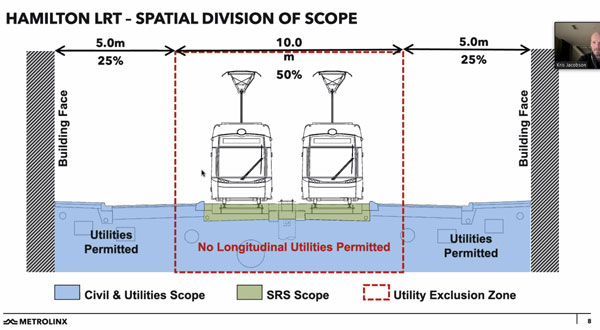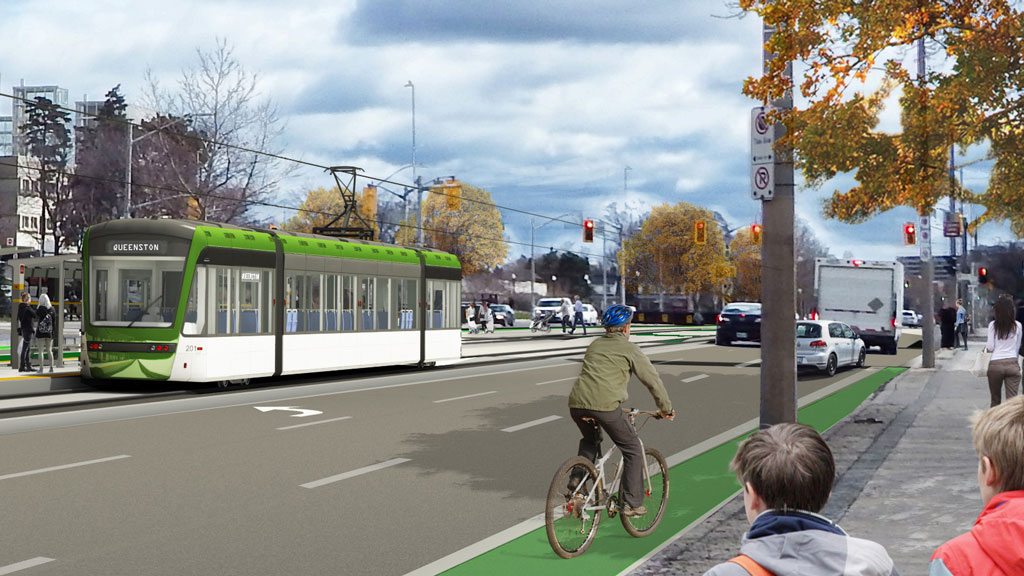Metrolinx and the City of Hamilton have spent the last half year picking up the pieces of the Hamilton LRT project, resurrected last year by the Ontario government, with most of the project slated to be the same as originally planned but with a possible major change in the procurement model.
As explained by Metrolinx’s technical project lead Kris Jacobson during a recent webinar, the project owners have decided the utilities-relocation phase of the $3.4-billion project is so fraught with risks that procurement may be split into two packages, with the utilities phase procured under the Alliance model.
Alliance, characterized by extensive collaboration from all stakeholders, would offer a “no-blame, no-claim environment, where it is our role to just basically get this work done,” said Jacobson.
He said Alliance has elements of progressive design, integrated project design and integrated project delivery.
“From a packaging perspective, we’ve identified that the risk associated with moving those utilities around is just too significant to bundle it as part of the overall scope of the project like we were in the past and using a more traditional P3,” he told members of the Hamilton-Halton Construction Association assembled virtually for day one of the association’s annual Construction Forecast.
“We don’t know what exists underneath the corridor with all of these utilities.”
Jacobson later clarified in a statement that Metrolinx, Infrastructure Ontario (IO) and the government of Ontario have not decided on a final procurement strategy for the Hamilton LRT project. All decisions on procurement of the project are made in consultation with IO and the government.

The Hamilton LRT will run 14 kilometres from McMaster University in the west to Eastgate Square to the east, with 17 stops. A significant portion of the corridor will be only 20 metres wide, with the double-track guideway located in the centre occupying 10 metres, leaving five metres on either side for two single lanes of traffic.
Given the impossibility of doing future utilities work under the guideway, the project will require a complete relocation of all utilities along the full length of the route under the two narrow roadways.
Jacobson called it more of a utilities project than a transit project.
“Every watermain, every Bell duct structure, every gas main, everything you can think of that exists under the ground, we’re going to have to relocate everything.
“We have what’s called a touch-one, touch-all philosophy on this project, where even though we may only need to move one utility, the spatial constraints that exist on the corridor will require us to move pretty much and renew every single utility onto the road.”
The project, originally budgeted at $1 billion, was cancelled in December 2019 with Minister of Transportation Caroline Mulroney citing escalating cost estimates. The project was reinstated in May 2021 with the provincial and federal governments pledging billions more.
The costs could rise above the $3.4-billion current estimate if the utilities work — covered by what’s being tentatively called the Swept Path contract, which would include construction of bridges, roads, sidewalks and other structures besides the utilities — becomes problematic.
“Further complicating that is that this is an old corridor,” said Jacobson. “There are numerous utilities that exist under this road, under this corridor, in various states of repair and various vintages. Some we know about, some we don’t know about it. It’s very congested.
“That’s the nice part about the collaborative model, especially the Alliance contracting model, is we don’t have to waste time debating, you know, what’s an appropriate claim, what’s an appropriate delay.”
The contract would not be fixed price but rather a target-pricing contract, Jacobson explained, with a fully open book and Metrolinx able to audit it to ensure they’re getting value for money.
When a problem arises, “We agree to pay and move the project forward,” said Jacobson.
The tentative Swept Path timetable calls for an RFQ in the spring of 2022, an RFP going out in August 2022, design and cost development from March 2023 into 2024, and construction starting in early 2024. Jacobson said the timetable could be revised if a different procurement model is used.
If Alliance is used, a second contract, for the Stops, Rail and Systems phases along with operations and maintenance, could be procured through a traditional P3 DBFOM model. The RFQ could go out in early 2023, the RFP period could start in May 2023, design work could ensue through 2024 and construction is tentatively targeted for a late 2024 start.
“Since we de-risked the project by moving all the utilities out of the way, by creating a sanitized corridor down the middle of the road, it should be relatively straightforward for a second contractor to come in and actually build the rail,” said Jacobson.
Building demolitions have started and other enabling works will be launched this year.
Other civil projects to be undertaken include construction of an operations, maintenance and storage facility; replacement of the existing Longwood Road Bridge; a new Highway 403 LRT flyover bridge; a new CP overpass bridge; and reestablishment of 62 traffic signals and thousands of streetlights.
Follow the author on Twitter @DonWall_DCN.











It clear we are seeing No Cost for the underpass at Gage.Other big ticket item also RHVP bridge at Queenston Rd.Other big ticket cost.This LRTproject WILL be over budget.Metrolinx has a limit not true it will cover the over cost.Will we see the great political tool SILENCE?